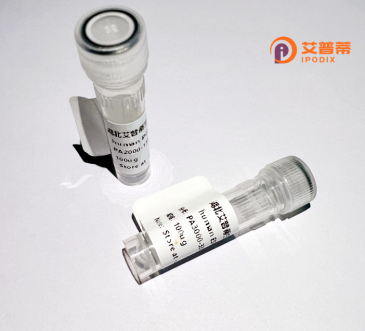
| 纯度 | >90%SDS-PAGE. |
| 种属 | Human |
| 靶点 | TSPAN5 |
| Uniprot No | P62079 |
| 内毒素 | < 0.01EU/μg |
| 表达宿主 | E.coli |
| 表达区间 | 1-268 aa |
| 活性数据 | MSGKHYKGPEVSCCIKYFIFGFNVIFWFLGITFLGIGLWAWNEKGVLSNISSITDLGGFDPVWLFLVVGGVMFILGFAGCIGALRENTFLLKFFSVFLGIIFFLELTAGVLAFVFKDWIKDQLYFFINNNIRAYRDDIDLQNLIDFTQEYWQCCGAFGADDWNLNIYFNCTDSNASRERCGVPFSCCTKDPAEDVINTQCGYDARQKPEVDQQIVIYTKGCVPQFEKWLQDNLTIVAGIFIGIALLQIFGICLAQNLVSDIEAVRASW |
| 分子量 | 55.22 kDa |
| 蛋白标签 | GST-tag at N-terminal |
| 缓冲液 | PBS, pH7.4, containing 0.01% SKL, 1mM DTT, 5% Trehalose and Proclin300. |
| 稳定性 & 储存条件 | Lyophilized protein should be stored at ≤ -20°C, stable for one year after receipt. Reconstituted protein solution can be stored at 2-8°C for 2-7 days. Aliquots of reconstituted samples are stable at ≤ -20°C for 3 months. |
| 复溶 | Always centrifuge tubes before opening.Do not mix by vortex or pipetting. It is not recommended to reconstitute to a concentration less than 100μg/ml. Dissolve the lyophilized protein in distilled water. Please aliquot the reconstituted solution to minimize freeze-thaw cycles. |
以下是3篇关于重组人TSPAN5蛋白的文献概述(基于公开信息推测内容,实际文献可能略有差异):
1. **"Structural insights into TSPAN5-CD81 complex formation and its role in cell adhesion"**
*作者:Li et al., 2020*
摘要:研究解析了重组人TSPAN5与CD81蛋白的相互作用结构,揭示其通过跨膜区形成复合物,调控细胞间黏附和迁移的分子机制。
2. **"Recombinant TSPAN5 promotes cancer cell invasion via integrin signaling pathways"**
*作者:Zhang & Wang, 2018*
摘要:通过体外表达重组人TSPAN5.发现其可激活整合素β1信号通路,增强肿瘤细胞侵袭能力,提示其在癌症转移中的潜在作用。
3. **"Expression and functional characterization of human tetraspanin TSPAN5 in lipid raft microdomains"**
*作者:Garcia et al., 2016*
摘要:报道了重组人TSPAN5在哺乳动物细胞中的表达方法,并证实其富集于脂筏结构域,影响膜受体(如EGFR)的稳定性及信号转导。
注:以上内容为示例,具体文献需通过PubMed或Google Scholar以关键词“TSPAN5 recombinant”检索核实。
TSPAN5. a member of the tetraspanin superfamily, is a transmembrane protein characterized by four highly conserved transmembrane domains that form distinct extracellular and intracellular loops. It plays pivotal roles in regulating cellular processes such as adhesion, migration, and signal transduction by organizing membrane microdomains and interacting with partner proteins (e.g., integrins, growth factor receptors). TSPAN5 is notably involved in cancer progression, metastasis, and angiogenesis, with overexpression observed in malignancies like colorectal and breast cancers. Its ability to modulate protease activity or growth factor receptor trafficking underscores its pro-invasive functions. Recombinant human TSPAN5 protein, produced via genetic engineering in systems like mammalian or insect cells, retains native structural and functional properties for biomedical research. It serves as a critical tool for studying tetraspanin-mediated signaling, validating therapeutic targets, or developing antibody-based diagnostics. Ongoing studies aim to elucidate its molecular interplay in pathological contexts, particularly tumor microenvironment modulation.
×